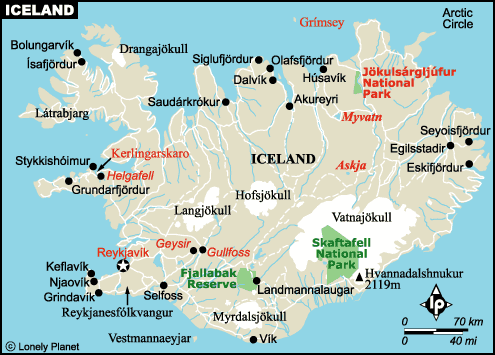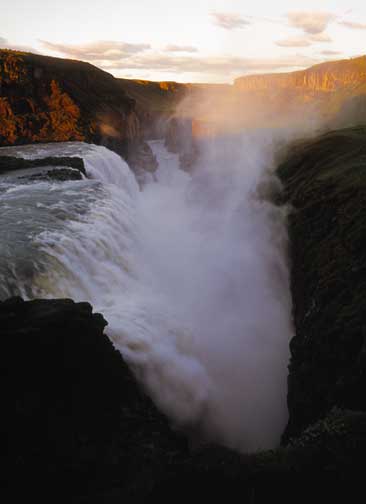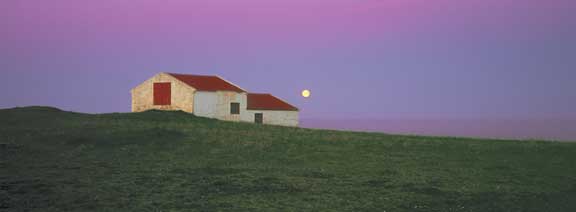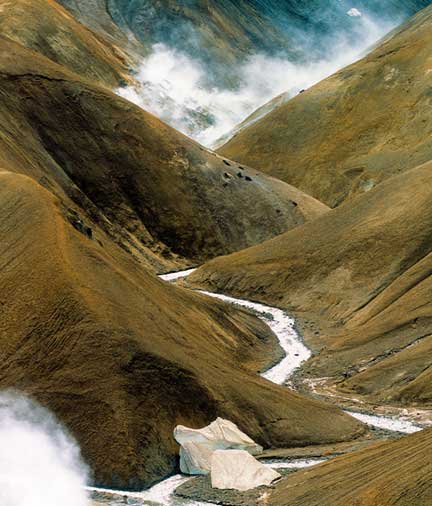This article and portfolio are intended to provide not a travel guide, but rather an inspiration for landscape and nature photographers seeking a new and challenging location to explore. Iceland is without any doubt the most visually exciting place that I have ever photographed. I hope that this page helps you in planning a visit to the land of fire and ice.
This page has a large number of photographs and therefore may take a while to load on computers with dial-up connections. I usually break large articles and portfolios into separate smaller pages to make loading faster, but in this case I wanted to maintain a continuous narrative.
Also, as always on this site, photographs with frames the colour of this text can be clicked so as to view a larger version.
The Idea
If you’re a landscape photographer you know that there are precious few places left in the world that offer a dramatic and accessible landscape and that have not been photographed to death, the way the American southwest has.
I have now found that there is at least one such place left‚ Iceland.
I’m not quite sure when the idea first occurred to me. Chris Sanderson, my friend and the director ofThe Video Journal(and traveling companion for this trip), had mentioned that Iceland was a favorite location for European cinematographers looking for dramatic landscape locations when shooting car commercials. But regardless of origin, once formed the idea of shooting there became a passion. A week of landscape photography inIceland during the summer solstice.
What did I really know about Iceland before this trip? Hardly anything. Some fuzzy memories from high school geography class and superficial impressions from the occasional TV documentary. Volcanoes, glaciers and sheep pasture were the dominant mental images.
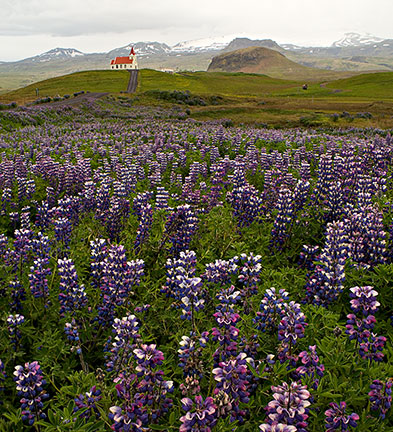 Church & Lupins‚ Iceland, June 2002
Church & Lupins‚ Iceland, June 2002
Photographed with a Pentax 67II and 55-100mm f/4.5 zoom on Provia 100F
When I show this print to people the universal comment is, "It looks like something from a storybook". Indeed. The whole country seems that way to me.
The challenge with this photograph was the need to hold as much depth of field as possible, Vs. a high enough shutter speed to prevent the Lupins from blurring as they swayed in the wind. This image was the best compromise out of about a half dozen frames.
This church is called Ingjaldsh—ll and is located out at the tip of the Snaefelness Peninsula near the town of Hellissandur.
After some initial research it seemed to me that the potential could be terrific, especially if timed to coincide with the longest day of the year. The Arctic summer sun would provide 24 hours a day of light, with as much as 6 hours daily of "golden light". In fact once the sun had set it wouldn’t even get dark enough for the stars to come out. They don’t start to reappear until August when one is this close to the Arctic Circle.
And, a quick glance at an astronomical ephemeris showed that by a stroke of luck there would also be a full moon during the same week as the solstice this year (2002). A photographic double header.
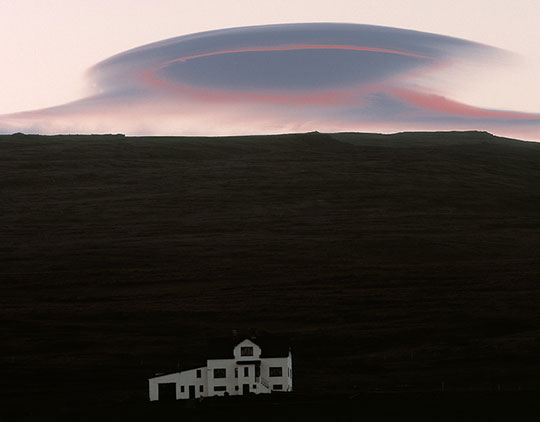 Ringed Cloud‚ Iceland, June 2002
Ringed Cloud‚ Iceland, June 2002
Photographed with a Pentax 645II and Pentax 300mm (67) ED-IF f/4 lens on Provia 100F
It was 2am on the day after the summer solstice and we were driving on Hwy 1 close to the Arctic Ocean. This bizarrely illuminated lenticular cloud started to form and we quickly stopped to photograph it. A farmhouse was on the hillside before us. (Sunrise was 1 hour later, at 3am).
To hold both the sky and the foreground would have required the use of a 3 stop split ND filter. I had one close by in the truck, but decided not to use it‚ instead letting the foreground go dark, adding to the mystery of this already remarkable scene. (In a print there is some detail visible. It just doesn’t show up well on the Net).
This photograph is my Featured Image for June, 2002.
The Preparation
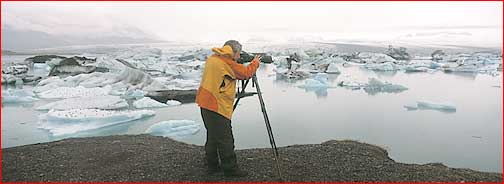
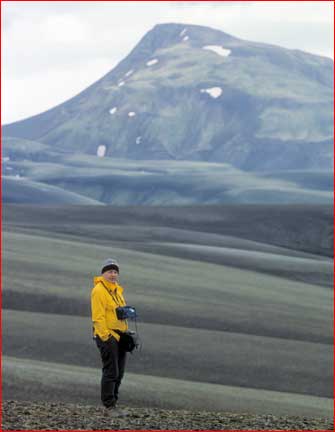
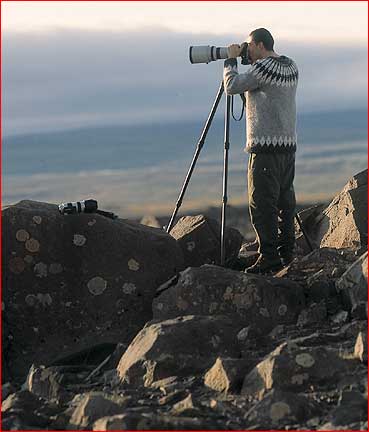
Chris Sanderson
Daniel Bergmann
I was accompanied on this trip byVideo Journalcameraman and director Chris Sanderson. During the trip’s final two days we were joined by Icelandic nature photographer Daniel Bergmann, who helped us explore some of the more remote and exotic locations in the Highlands.
The planning for this trip turned out to be more comprehensive than for most photographic expedition, yet in the end I went in almost blind. This is because there is hardly any detailed information available on doing landscape photography in Iceland. There is even a shortage of travel guide books. The only useful one that I could readily find wasThe Lonely Planet Guide, but regrettably it was found to contain quite a bit of misinformation. (For example, and contrary to the book, there arenomosquitoes in Iceland).
Some initial research showed that there is relatively little in the way of tourist infrastructure in Iceland outside of the city of Reykjavik. Half the population of the country lives in the capital city. The city and the locales close by are where most tourists venture, usually on a whirlwind one-day bus tour.
Therearetourist accommodations outside of Reykjavik, but except for some hotels in larger towns these are few and far between, and during the summer when tourism is at its peak can require booking in advance. Also, it quickly became clear that Iceland can be a terribly expensive place to visit, especially for North Americans who already find everywhere in Europe expensive. Iceland ups the ante another notch.
For this reason we decided that we would be best served by camping, since I also didn’t want to have the constraint of deciding beforehand when and where we would stay for the night. In fact I anticipated that we would likely be doing some of our most interesting photography between 9pm and midnight, and again from 3am till 6am, because of the great light at those hours. Few guest houses would be happy accommodating travelers with this kind of schedule, and hotels were largely non-existent in the remote areas that we’d be traveling.
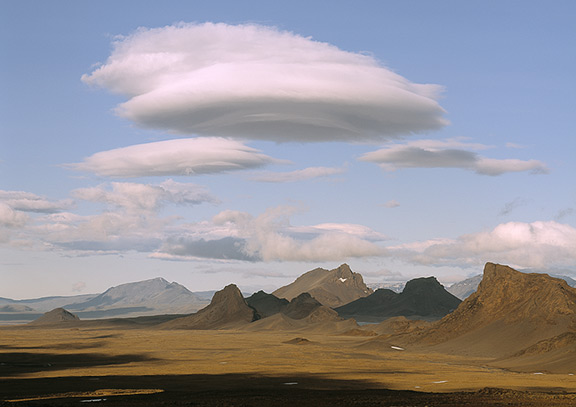 Mothership‚ Iceland, June 2002
Mothership‚ Iceland, June 2002
Photographed with a Pentax 67II and Pentax 200mm f/4 lens on Provia 100F
One of my strongest impressions from Iceland is of the clouds‚ among the most dramatic that I’ve ever seen. This cloud brings to mind the mothership inClose Encounters. Notice that the base of the cloud is similar to that in the mysteriousRinged Cloudphotograph found elsewhere on this page. Obviously something to do with the Arctic airflow and mountain ranges.
Fortunately one can camp almost anywhere and everywhere in Iceland when outside of towns and away from farms, so I anticipated little problem. I expected that we would likely pitch camp in the mid-morning, after our sunrise shoot, and then sleep for 5 or 6 hours during mid-day. Otherwise we’d be driving, location scouting and shooting in the late afternoon and through the evening.
But, camping in ones home country in ones own vehicle is one thing. Bringing everything that’s needed, from tent to sleeping bags to cooking gear on an international flight‚ especially when one is already flying with a load of camera gear, is not a trivial undertaking. But in the end we managed to get all of the camping apparatus needed for two people into a single duffle bag.
Food would be another issue. Along with a shortage of hotels and inns I had read that there was a definite lack of decent restaurant facilities. Fast-food grills at gas stations were described as the only places to eat when outside of the major towns. We therefore had to anticipate preparing our own meals when we camped, and eating sandwiches we made ourselves during the day.
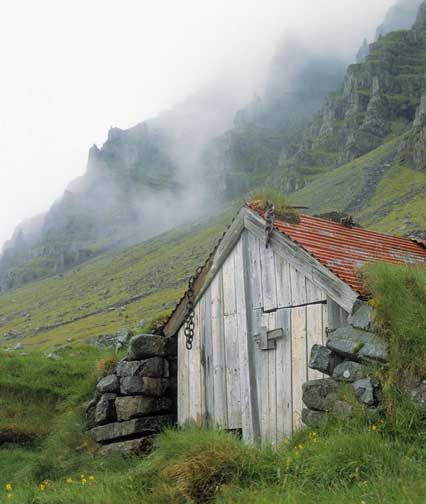 Chained Hut‚ Iceland, June 2002
Chained Hut‚ Iceland, June 2002
Photographed with a Pentax 67II and 55-100mm f/4.5 zoom on Provia 100F
We got lucky with the weather. During our 7 days in Iceland it was heavily overcast and rainy for only one solid day. Given that the inverse could as easily have been true we were indeed fortunate. But, the overcast day produced some memorable images, such as this sod-covered hut with fog shrouded cliffs in the background. The heavy sea chain is to hold down the tin roof during high winds. Taken at 55mm (28mm equivalent in 35mm terms).
Weather was our biggest concern during the planning stages, especially because we would be outdoors virtually 24 hours a day for an entire week. Iceland, notwithstanding its name, is warmed by the Gulf Stream, and Reykjavik actually has milder winters than New York or Berlin. But, summers are brief, cool and often rainy. As we prepared to leave in mid-June we read online that while the roads that circumnavigate the island were all open, some interior 4WD tracks were still snow covered. Frankly, we didn’t know what to expect.
Travel from Toronto would be viaIcelandic Air,which we would connect to in Boston following an Air Canada flight from Toronto. From Boston it would be a five hour overnight flight to Reykjavik. Fares were reasonable.
It was clear that once we got there our means of transportation would be a 4WD rental vehicle. There are plenty of unpaved roads and tracks that we would want to take. Also, traveling with camping gear meant that even though there were just two of us we would need room not only for our clothes but also camera equipment, tent, sleeping bags and cooking gear.
As for camera equipment, I decided that I would shoot primarily with my Pentax 67 outfit, (67II body and 4 lenses, with the Pentax 645II body as backup and for primary use with the 300mm lens), but I also brought along the Hasselblad XPan and its three lenses. 50 rolls of 220 film and 30 rolls of 35mm Provia 100F along with tripod, filters, meters and such rounded out the outfit.
The Trip
We landed at Keflavik, Iceland’s international airport, at 7am after a 5 hour flight from Boston. It was heavily overcast and drizzling as we loaded our gear into the rentedSuzuki Grand Vitara. This is a small SUV by North American standards, and itjustheld the two of us, our camera and camping equipment, and our clothes. We used the back seat for our camera gear and the rear hatch space for everything else. It was cramped, but adequate. The Suzuki performed admirably, both on paved roads and rough highland 4WD tracks.
Our first stop was a grocery store for food and other provisions, including butane for our camp stove. This can be picked up at almost every gas station. We drove past Reykjavik, bypassing the city on the ring road. One sight of the MacDonald’s and Pizza Hut signs was enough. While I’m sure it’s a lovely town, our destination was the mountains and fiords, not multinational clothing shops and fast food restaurants. To our delight the clouds lifted by mid-morning, and we only had one other day of weather during the rest of the week.
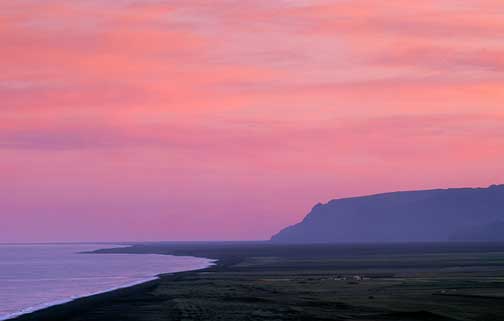 2am Light‚ Iceland, June 2002
2am Light‚ Iceland, June 2002
Photographed with a Pentax 67II and Pentax 200mm f/4 lens on Provia 100F
After photographing moonrise over the North Atlantic we relaxed, chatting, eating a sandwich and waiting for sunrise. This view down the southern coast was taken at 2am. It was still light enough to read a newspaper.
Our trip covered some 3,000 Km (1,800 miles) during 7 days of driving. We circled almost the entire country on Highway 1 and also explored the interior southern highlands. The road (4WD track) that crosses the interior from north to south was still closed due to snow during the last week of June, but was scheduled to reopen within a week or so of our late June visit.
I won’t provide a location-by-location travelogue. That’s not my style or intent. But I will mention the places that I found most appealing from a photographic opportunity perspective. These include:
The Snaefelness Peninsula. This is about a 4 hour drive from the airport. If you only have one or two days, this is a great place to spend your time. A small glacier occupies the center of the peninsula and there are wonderful sea vistas. The private campsite at Arnarstapi is very good and features a decent small restaurant.
The West Fiords. It’s a long and sometimes tedious drive over twisting mountain 4WD roads (some under construction), but the scenery is breathtaking. At the tip of the southern part of this peninsula isLátrabjarg, the westernmost point of Europe. It is home to the largest bird-cliff in Iceland and home to millions of nesting seabirds. What makes it especially appealing is that it is the world’s finest location for photographing Puffins. There is also a lovely public camp site on the ocean shore just a couple of kilometers from the lighthouse and cliffs. A spectacular place to spend a day and a night.
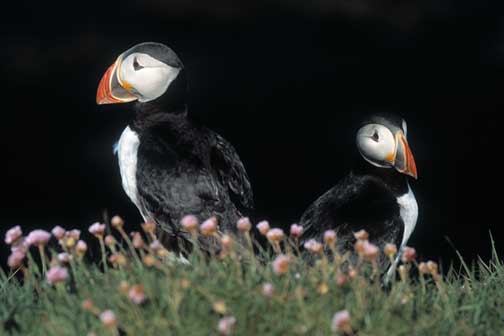 Puffins2‚ Iceland, June 2002
Puffins2‚ Iceland, June 2002
Photographed with a Pentax 645II and Pentax 300mm (67) ED-IF f/4 lens on Provia 100F
Photographing Puffins at Látrabjarg is like falling off a log. They are so unafraid of humans that you can literally reach out and touch them. Here I used a longish lens (300mm; 180mm in 35mm terms) to flatten perspective. I also used a polarizer, and underexposed 2/3rds of a stop to avoid burning out their white faces. Combined, this darkened the ocean background to the point where this almost looks like a studio portrait set-up.
Akureyri and Environs:The loveliest small city in Iceland is Akureyri. Nearby Lake M½vatn is, I am told, a birders paradise. The light was low when we were there and since our main focus was landscape, not birds, we moved on.
This is a major active thermal area, and close by is the Krafla geothermal power generating station. We drove up the road to the power plant more out of curiosity than an interest in photography, but when we got there discovered that the architectural photography opportunities were remarkable‚ especially with the wide format Hasselblad XPan.
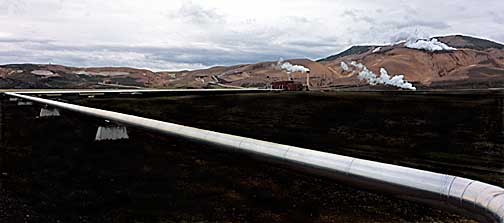 Krafla Geothermal Power Plant‚ Iceland, June 2002Photographed with a Hasselblad XPan and 30mm f/5.6 lens on Fuji Provia 100F
Krafla Geothermal Power Plant‚ Iceland, June 2002Photographed with a Hasselblad XPan and 30mm f/5.6 lens on Fuji Provia 100F
Surprisingly, and though we were there quite late in the evening, access to the grounds of the plant was open, with only a few restricted areas. This stainless steel pipe with steam rising in the background seemed custom made for the XPan 30mm ultra-wide lens. In processing this image I’ve burned in the messy foreground somewhat to accentuate the sweep of the pipeand the otherworldliness of the locale.
Jökulsárl—n:This is a glacial lake into which the vast Breidamerkurjökull glacier (the third largest in the world) calves icebergs. It is located right on Highway 1, between the town of Höfn and Skatafell National Park. Simply put, it is a must see for any photographer visiting Iceland.
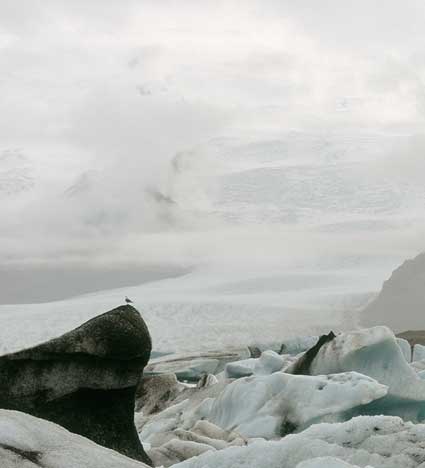 Bird on Berg at Jökulsárl—n‚ Iceland, June 2002
Bird on Berg at Jökulsárl—n‚ Iceland, June 2002
Photographed with a Pentax 645II and Pentax 300mm (67) ED-IF f/4 lens on Provia 100F
The low key and monochromatic combination of white icebergs, glacier, clouds and birds lead to some very appealing images, most of which only work in large prints, rather than on the Net. This one has the greatest contrast and therefore works best here to illustrate the possibilities. The unusual black iceberg is caused by an accumulation of wind-blown volcanic black sand on the glacier.
Central Highlands:Not too far from Reykjavik, this vast area contains some of the most fascinating photographic terrain in Iceland. This includes the fabulous Selfoss waterfall, volcanoes, lava fields, craggy mountains and geothermal areas.
The Costs
With one exception photographic travel in Iceland can be quite inexpensive. If one camps (and there is little alternative if you want to be able to shoot in the best light), the costs are minimal, and when camping food costs can be moderate as well. Flying to Iceland onIcelandic Air, either from the U.S. or Europe is also relatively inexpensive. The real killer is the cost of renting a 4WD vehicle. We paid U.S. $1,500 for aSuzuki Grand Vitarafor one week, roughly triple what a similar vehicle would cost in the U.S. Some Europeans take the car ferry from Europe and bring their own vehicle, but this only makes economic sense if you’re coming for more than a couple of weeks.
The Driving
A 4WD vehicle is a must. Don’t even think about doing a photographic tour of Iceland in a sedan. Other than Highway 1 which circumnavigates the island, the vast majority of interior roads are unpaved, and the ones that lead to the more exciting locations are rough tracks that need four wheel drive, low range and high ground clearance. There are numerous times that you’ll be fording streams, which also makes high ground clearance a necessity.
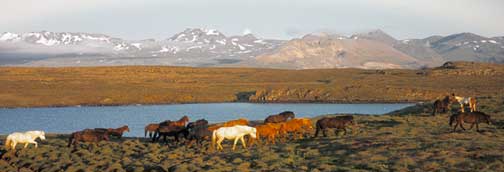 Horses at Moonrise‚ Iceland, June 2002
Horses at Moonrise‚ Iceland, June 2002
Photographed with a Hasselblad XPan and 90mm f/4 lens on Fuji Provia 100F
After driving the southern part of the West Fiords we took a 3 hour car ferry back to the Snaefellsnes peninsula rather than drive the twisty mountain roads again. They were under construction and very slow. Upon driving off the ferry at about 10:30pm we saw this scene, with a group of distinctive Icelandic ponies in foreground and the rising full moon just peeking over the distant fog shrouded mountains.
Sheep are the biggest hazard when driving in Iceland. They are everywhere! Being the incredibly stupid animals that they are they wait until you’re almost upon them and then decide to run across the highway, right in front of your vehicle. The car rental agent at the airport warned us that sheep were the biggest cause of auto accidents among tourists. I can well believe this.
The Time of Year
Our trip was designed to coincide with the summer solstice and full moon at the end of June. This turned out to be a great time to visit Iceland as well because the European tourist invasion had not yet started. Most Europeans take their vacation in August (some in July) and at the end of June school is still not out yet in many countries. We found most places to be relatively uncrowded.
The Accommodations
When camping prices range from free to $10 – $15 a night for a campsite. The larger and more organized campsites have toilets and showers, but frankly my preference is the smaller sites. The fewer the amenities the fewer the people, and that’s to my taste.
After 3 days of camping without a shower we started to get desperate, and ended up bathing naked in an icy cold river by the side of the highway at 5am. Fortunately not a single car came by during that time, but we were desperate and wouldn’t have cared even if one had. The cold glacial water was enough to cause cardiac arrest, but at least we were relatively clean again.
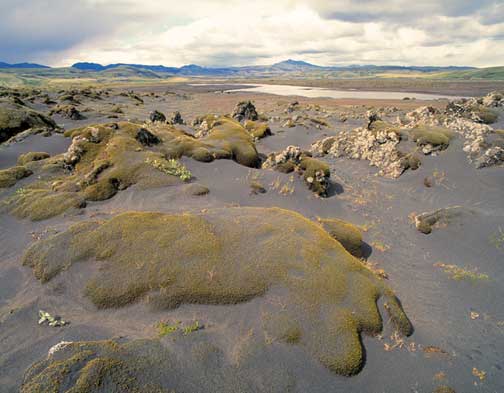 Moss & Lava‚ Iceland, June 2002
Moss & Lava‚ Iceland, June 2002
Photographed with a Pentax 67II and 45mm f/4 lens on Provia 100F
Black lava sand, moss, rivers, distant mountains, Arctic clouds‚ all the ingredients are provided. All one need do is mix them together in the right proportion. Here I used a 45mm lens (21mm equivalent) to accentuate the organic shape of the rock and to provide the sense of depth that this landscape requires.
By the fourth day, during which we had done a long overnight drive in the rain, we hadn’t the stamina or inclination to set up camp in the rain, and so we checked into a hotel in the town of Höfn . We only stayed some 5 hours, but the cost was about U.S. $150. In terms of size and amenities the room was belowMotel 6level by North American standards. As I’ve said‚ camping is the preferred way to go for photographers, for a variety of reasons.
The Hours
Landscape and wildlife photographers live a different schedule from that of most people. Put them into an environment like Iceland in mid-summer, with 21 hour long days, and it getsreally weird. In fact since the 3 hours when the sun was below the horizon were light enough to read a newspaper‚ twilight, not even dusk‚ there really were 24 hours a day to shoot in. Given the spectacular scenery the big question was,when and where would we sleep?
The answer turned out to be‚ not often, and anywhere we could. Typically we would pitch camp in the mid-morning, just as other campers were packing up to leave. We would prepare a meal, usually soup or pasta, pitch our tent and then sleep for 2-3 hours. By noon we’d be on the road again. By 6 or 7pm we’d be exhausted and would pull over, recline the seats and catch 1-2 hours of sleep in the truck by the side of the road. We’d do this again between 1 and 2am unless the light and location were really great, in which case we’d just keep shooting and/or driving.
As you can imagine, by the end of the week we were exhausted and feeling really sleep deprived. When you view some of the segments of theVideo Journalthat we shot during this time you’ll see what I mean. In some of them I look and sound like a zombie. But, needless to say, it was a thrilling week. I now have the rest of the summer to catch up on my sleep.
I should point out that having two people driving was a necessity. The passenger would frequently doze for a while, and only when there was a shot to be had would the driver wake him. If the driver became too sleepy he’d simply pull over so both of us could nap.
The Light
Because the sun is relatively low, even when at the zenith, much of the day is suitable for landscape work. For this reason "golden light" also lasts a long time, typically from 9pm to midnight and again from 3am to 6am. This means that one doesn’t have to rush a good shot for fear that the light will change.
The Wildlife
While there are Reindeer in the interior, and Arctic Foxes in many locales, the real wildlife opportunity is bird photography. Daniel Bergmann describes one of thepremier bird areason his web site.
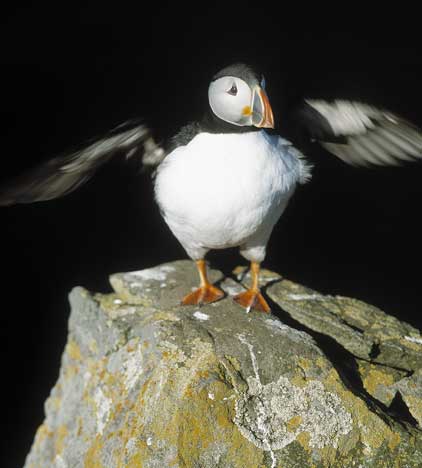 Puffin Takeoff‚ Iceland, June 2002
Puffin Takeoff‚ Iceland, June 2002
Photographed with a Pentax 645II and Pentax 300mm (67) ED-IF f/4 lens on Provia 100F
But as good as the popular birding areas are, there are birds found in profusion throughout the country and they can frequently be used as compositional elements in landscape work.
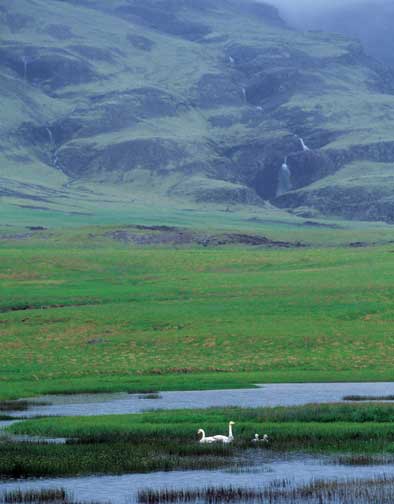 Swans and Waterfall‚ Iceland, June 2002
Swans and Waterfall‚ Iceland, June 2002
Photographed with a Pentax 645II and Pentax 300mm (67) ED-IF f/4 lens on Provia 100F
This image deserves a sidebar. It was mid-morning and we had stopped by the side of the highway to photograph this swan family and picturesque waterfall in the misty distance. Though we were well and safely off the road a large truck pulled to a stop a couple of hundred feet from where we stood. At first I thought that the driver was annoyed, and that we were somehow being unsafe, or were blocking the road. (We weren’t). Instead, he simply hadn’t wanted to drive through our shot. He waited till we were finished shooting, and then with a smile and a wave drove past. You’ve gotta love a country where truck drivers are nature photography fans.
Worth noting is that this shot was taken during a heavy rainfall, adding to the misty romantic feel of the light.
The Waterfalls
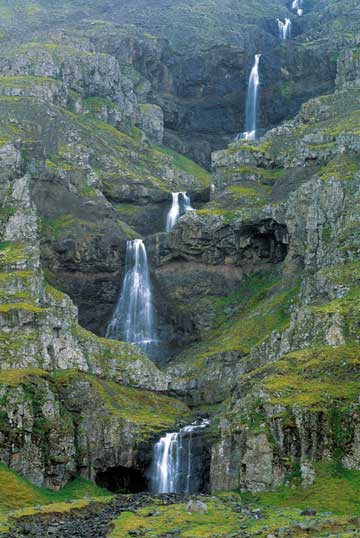 Waterfall‚ Iceland, June 2002
Waterfall‚ Iceland, June 2002
Photographed with a Pentax 645II and Pentax 300mm (67) ED-IF f/4 lens on Provia 100F
The waterfalls in Iceland are legion. It seems that everywhere that you turn there is one more beautiful than the other. Indeed there are countless unnamed falls like the one seen above, that if they were anywhere else in the world would rate a tourist tour-bus stop and a hot dog stand. In Iceland they are just there‚ unlabeled and unspoiled‚ just for your viewing pleasure.
Photographed with a Pentax 67II and 55-100mm f/4.5 zoom on Provia 100F
There are two famous waterfalls ("foss" is the suffix for waterfall in Icelandic); Detifoss and Gulfoss. Detifoss, the largest waterfall in Europe, wasn’t terribly interesting photographically, but Gulfoss was magnificent. We arrived just after sunrise (3:30am) and found the falls and canyon suffused with beautiful warm light and rainbows.
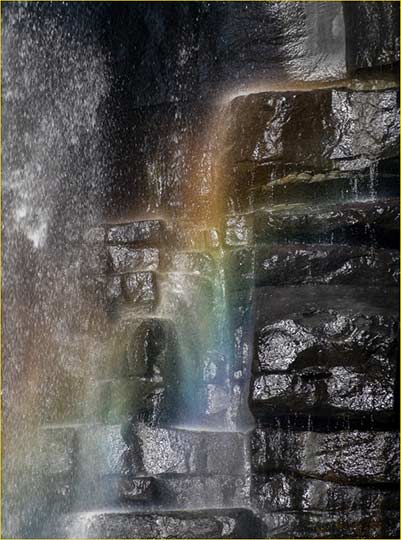 Seljalandsfoss ‚ Iceland, June 2002
Seljalandsfoss ‚ Iceland, June 2002
Photographed with a Pentax 67II and 55-100mm f/4.5 zoom on Provia 100F
We came across Seljalandsfoss (a lesser know but spectacularly beautiful falls) at the other end of the day, just before sunset. The warm light created fascinating shadows and rainbows, giving texture to the scene that (I was told) is not normally seen. The shutter speed for this frame was about 1/8th second; just about right for moving water. If only there had been a few clouds in the right position!
The Moon
Most landscape photographers are well aware of the timing of the moon’s phases, and plan their shoots accordingly. I was very pleased to discover that there would be a full moon within a couple of days of the summer solstice. This then became part of the week’s trip planning.
Photographed with a Hasselblad XPan and 90mm f/4 lens on Fuji Provia 100F
Using a Palm-software program I calculated the position of the rising moon, and we shot quite a number of frames as it did its slow dance above the North Atlantic. At this time of year and latitude it didn’t get more than 4 degrees above the horizon, both rising and setting in the south.
I did most of the shooting of this set-up with the Pentax 67 and a medium-long lens, filling the frame with the building and placing the moon just to one side. On the way back to the truck I took this frame with the XPan, almost as an afterthought. It turned out to be the most effective frame because it captures the two components that I’d concentrated on as well as the grassy hilltop and post-sunset sky glow, giving context to the whole thing.
As it turned out the night of the full moon was overcast, but nevertheless on other evenings the moon played an active part in several successful photographs.
A Midsummer Night’s Dream
Because at this time of year the full moon is only up for a brief time, and because sunset takes so long, you end up with the bizarre combination of the full moonand the sunsetting at the same time. I’m a bit of an amateur astronomer, and seeing this all happen was quite a thrill. Oh yes‚ the sun rises just east of north and sets just west of north. Combine these phenomena with jet lag and the disorientation caused by long shooting days and lack of sleep, and the combo is overwhelming.
The Gear
Equipment used on this trip fell into three categories; clothing, camping gear and camera equipment.
Clothing:We had expected colder weather than we actually encountered, so the turtle necked ski sweaters and long underwear went unworn. I usually wore jeans, a T-shirt, poly-pullover and down vest. When it rained I swapped the vest for a Gortex treated rain jacket and pants. I brought two pairs of waterproofed hiking boots and swapped them daily. Our clothes each fit into a medium-sized duffle bag.
Camping Gear:We used a 2-man, 3-season tent, zero degree Celsius rated sleeping bags, Thermarest sleeping pads, and a basic cookset with butane (Camping Gaz) stove. This all fit into a medium-sized duffle bag.
Camera Equipment:I brought the Pentax 67II, Pentax 645II and Hasselblad XPan. Lenses for the Pentax system were the 45mm, 55-100mm zoom, 200mm and 300mm along with 1.4X Extender. The 300mm and extender were used exclusively via adaptor on the 645 body. I had along all three lenses for the XPan; 30mm, 45mm and 90mm. My tripod was a Gitzo 1349 Carbon Fiber with Arca Swiss B1 head. Camera gear was packed in a LowePro rolling backpack, which was sturdy enough to ship as luggage.
I also brought along polarizing filters to fit all lens, and a Lee filter system with split neutral density filters to fit all lenses. The Lee filter kit and tripod were packed in my clothing bag for flying.
During the 7 days of shooting I exposed about a thousand frames. Probably 350 of these were brackets and another 350 were variations on framing. This left some 300 setups‚ about 40 a day. In the end I have about 20 exhibition quality prints from the shoot, and 3 or 4 images that are portfolio grade‚ destined for my next book. This is a very high success ratio. I usually am very happy to end up with a third of this output from a week-long shoot.
I experienced a minor mishap with my camera equipment. The large wooden grip which I use to stabilize the Pentax 67 with long lenses must have suffered a several jolt at some point because the locking pin on the body was knocked loose. No harm done that impacted my shooting, but surprising given how rugged the Pentax 67 usually is. A bit of gaffer tape covered the hole in the body to keep water and dust out. Otherwise everything survived both of the flights, rugged handling during the shoot, and some very wet conditions on one of the days.
I brought my GSM mobile phone and was able to use it for both local and international calls much of the time. Iceland has cell phone service in all towns of more than 300 people. It was somewhat bizarre to be in such an exotic location and still be able to check in with family and other contacts from time to time. Such is our wired world.
On this trip I brought along a new small audio recorder for making trip and shooting notes. It’s an Olympus DS-300, featuring 2.5 hours of high quality digital recording (5 hours in LP mode), and the ability to transfer files to ones PC. This proved to be an excellent device, reliable, and easy to use. The random access capability of a digital audio recorder really makes pocket recorders that use tape obsolete.
Oh yes. One more essential piece of equipment for shooting in Iceland in mid-summer. Eye shades. Sleep (what little you’ll get) will be impossible without them.
The X-Rays
Film was carried on the plane in a small rucksack. It was X-Rayed 6 times in all on the roundtrip, in Toronto, Boston and Keflavik. This caused no visible damage to the film. Interestingly, at Boston’s Logan airport on the way home I asked for a hand check on the bag of exposed film. This was refused, and a supervisor immediately came over. I asked again (calmly and politely) and she waived over a policeman.
I explained that the film had now been X-rayed many times and that I was concerned about this repeated exposure. I explained that I was a professional photographer and that FAA rules permit passengers to request a hand inspection of film. The cop and supervisor had no patience for this. I was told that the FAA rules are a minimum guideline (not true) and that if I wanted to board the plane my film would be X-rayed. No discussion, no alternatives. Needless to say I permitted the film to be X-rayed. Such is the legacy of our post-911 world.
The Books
There are two photography books that deserve a place on your bookshelf if Iceland captures your interest. The first is the newly publishedLost in Iceland, by Sigureir Sigurj—nsson, ISBN 9979-53-439-7. The second isAurora, by Sigurdur Stefnisson, ISBN 9979-761-69-5. Unfortunately neither appear to have distribution outside of Iceland, though any good bookseller should be able to order a copy for you.
Lost in Icelandcontains many lovely images that capture the essence of the Icelandic landscape. But as appears to be the case with much landscape photography by Icelanders, there are too many images with people in them for my taste.
Aurorais the work of a photographer that specializes in photographing this phenomenon, which because of its northern location and long dark nights Icelanders are blessed with in abundance. I can only stand in awe of his dedication to this project. His photographs are magnificent. You can see some of his work in thumbnail formhere.
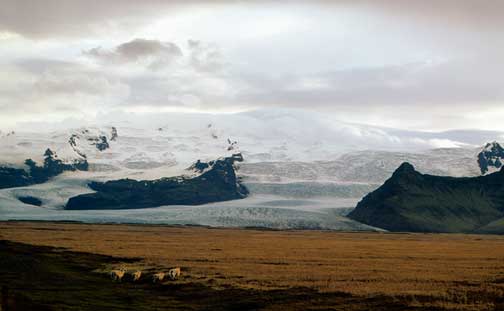 Sheep & Glacier‚ Iceland, June 2002
Sheep & Glacier‚ Iceland, June 2002
Photographed with a Pentax 67II and 200mm f/4 lens on Provia 100F
Two icons dominated my impression of Iceland, in addition to waterfalls. These are the sheep and the glaciers. Here we see them together. Daniel has commented that one of the problems with the work of most Icelandic landscape photography is that either sheep or people are almost always included, for scale. I must admit that without these sheep a sense of the vastness of this particular landscape would not have been properly conveyed.
The Workshop
As our week in Iceland came to a conclusion it became clear to me that a future workshop in Iceland would be a must. I discussed this with Daniel Bergman and he has agreed to co-teach one with me. We have tentatively scheduled to do this in July, 2004. It is too soon to provide details, but if you’d like to have your name added to myWorkshop Waitlist, please fill out the form. Mention in theCommentsfield that you’re interested in the Iceland workshop, and when details become available you’ll be among the first to know. (No obligation‚ of course. Also, your name and e-mail address will not be given to or used by anyone other thanThe Luminous Landscape Inc).
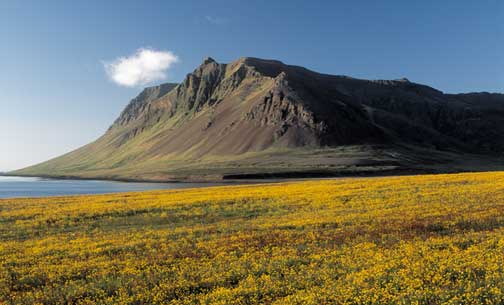 Yellow Field & Cloud‚ Iceland, June 2002
Yellow Field & Cloud‚ Iceland, June 2002
Photographed with a Pentax 67II and 55-100mm f/4.5 zoom on Provia 100F
Even though one knows that Iceland is a green country in summer, the fact that it can be as colourful as a spring day in England still comes as a shock to the first-time visitor. It shouldn’t be calledIceland. I should be renamed Colourland.
The Video Journal
Issue #5 ofThe Video Journalreleased in July, 2002, featured an interview with Icelandic nature photographerDaniel Bergman, as well as a review of theHasselblad XPan,featuring images from this shoot in Iceland. A feature travel article on Iceland will appear inIssue #8of The Journal, which will be published in August, 2003‚ in time for you to plan your own trip there for that coming summer.
Photographed with a Pentax 645II and Pentax 300mm (67) ED-IF f/4 lens on Provia 100F
There are numerous places around the island where there are fumaroles. In addition to the sulphur smell there are sometimes great clouds of steam. At this highlands location a river runs through a sinuous valley with steam rising at either end. To give you a sense of scale; the river is about 25 feet wide and the larger foreground snow chunk about 50 feet high.
Iceland Update
If you’re interested in both an exciting new Geographic magazine about Iceland and also finding out about a serious corporate challenge to the pristine Icelandic landscape have a look at my October, 2002update.
Update 2003
I returned to Iceland for another shoot in the summer of 2003 and there are now two new portfolios online;Iceland in BlackandIceland 2003.
Iceland — Summer 2004
Two week-long photographic expeditions in Iceland with Michael Reichmann
Limited Availability — Act Now
You May Also Enjoy...
Noctilux
Leica f/1.0 Noctilux The World's Fastest Rangefinder Lens When it comes to photographic tools, for some photographers cameras are what fascinates. For me and
Meteor
While this tutorial on photographing meteors was written for one particular meteor shower, the Leonid shower of Nov 18, 2001, it can be used any
